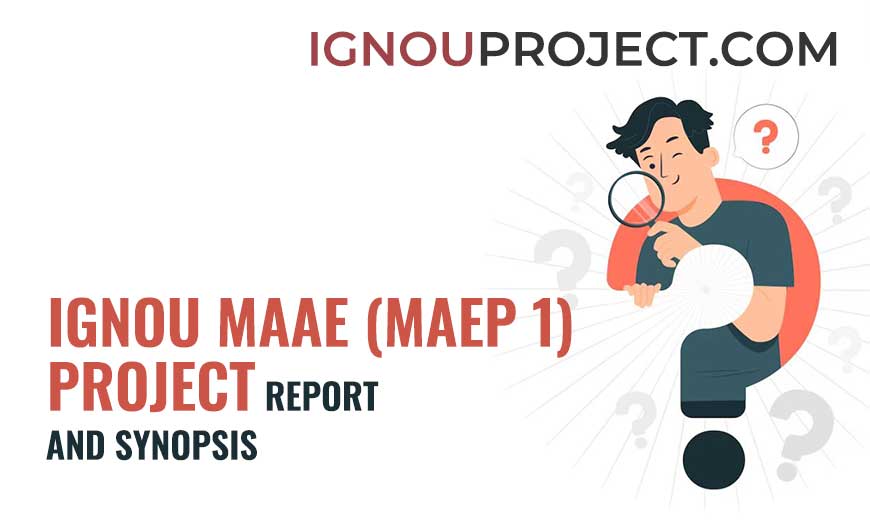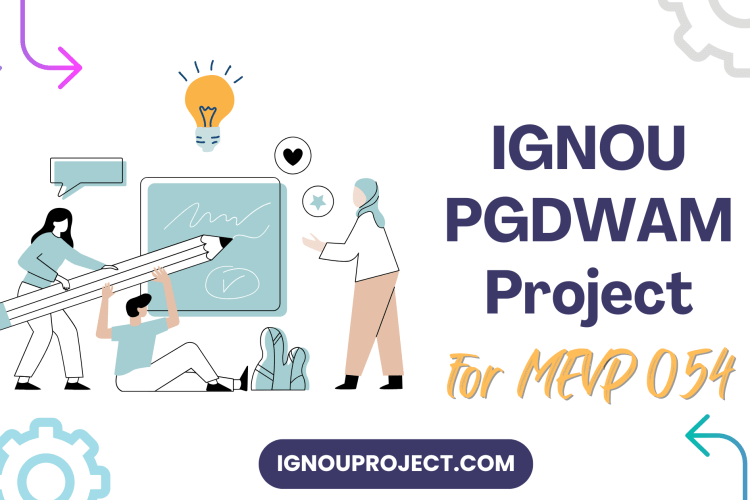
You will have the opportunity to obtain practical experience in the IGNOU MAAE Project Synopsis (MAEP-1) by doing a research study on a subject of your choice in the field of adult education and reporting the findings in the form of an IGNOU MAAE Project work. It will not only provide learning experiences that will allow you to understand and appreciate adult education’s knowledge structures and paradips, but it will also develop you as a budding professional researcher capable of participating in the knowledge generation process and even bringing in effective paradigm shifts in adult education such as participatory research, community action-research, phenomenological research, and so on. As a result, it fosters a community of academics who are well-equipped to conduct adult education research studies and supports intense theoretical and research discourses and activities for the development of individuals, communities, and the nation.
We produced this blog titled “How to Write the IGNOU MAAE Project, MAEP 1 Dissertation, and Synopsis.” to aid you in planning, organizing, systematizing, and executing your obligations at various stages of this job. It is intended to offer you structured, practical experience doing adult educational research. In other words, this blog post outlines the entire process of doing the research project.
Whatsapp us to get the Personalized (Customized) IGNOU MAAE Project Dissertation and Synopsis
Download Link for IGNOU MAAE Project (MAEP 1 PDF)
IGNOU MAAE Project Synopsis (MAEP-1) Components
While creating the IGNOU MAAE Project Synopsis for MAEP-1 Project work, you must include some components such as;
1) Project Synopsis Title: The IGNOU MAAE Project Synopsis title is the same as the problem title. The topic title appears on the first page of the proposal, along with the name of the researcher, the name of the supervisor, and the name of the University School to whom your research proposal is to be presented. The title should be factual and explicit, and it should not be too long or too short.
2) Introduction: This is the proposal’s first section. Some researchers refer to this caption (i.e. Introduction) as the “Background of the study.” This section correctly introduces the study’s topic. You will provide a brief description of your problem. You will describe how the problem emerged and why it is significant in the social environment in general, and in adult education contexts in particular. Some researchers use a separate caption ‘Rationale’ after the Introduction, while others use it as a sub-section under the ‘Introduction’ itself, dealing with the reason for doing the proposed study.
3) Problem formulation, definition, and statement: The problem statement and problem title are not the same thing. It plays an important role in the IGNOU MAAE Report. The problem statement is simply an expanded version of the problem title. You will construct, explain, and communicate the problem by focusing on specific components such as the research questions it tries to answer, the objectives it seeks to attain, the hypotheses it seeks to test, and the study’s scope restrictions.
4) A Synopsis of Relevant Literature: Some researchers include it as a separate section, while others include it after the ‘Rationale of the Study’ or combine it with it. The review of relevant literature focuses on two aspects: i) the problem’s theoretical background, and ii) past research activities in the subject. If the chosen subject is new and the concepts involved are unknown or have not been thoroughly researched, the researcher should provide a brief summary of the concepts. By reviewing several linked studies, the researcher can summarize the most significant and recent papers that demonstrate research trends, if any, pertinent to the issue. In other words, it is not necessary to thoroughly review every relevant research. It may not be exhaustive, but it should cover significant aspects of related research that trace the origins of the problem in the existing literature and encourage further investigation and analysis. It should demonstrate the researcher’s grasp of the subject as well as comprehension of recent breakthroughs in the field.
If you are interested in investigating the ‘Problems of female learners attending adult education facilities in rural locations,’ you can look into past studies that have been completed. In the review, several key findings and their implications for the planned study should be presented. It should focus on the substance of what has been done in the subject thus far, as well as the insights gained from the review, and it should include your review (opinions) of important literature, as well as the research gaps detected in the domain. The highlighted research gaps should provide a cause or solid foundation for justifying your IGNOU MAAE Project Synopsis.
5) Research Questions: When submitting an IGNOU MAAE Synopsis, the researcher should provide particular research questions that must be addressed. The research questions you develop generally lead to the development of the study’s objectives and, if any, hypotheses to be tested using evidence data.
6) Objectives: Generally, objectives are developed in relation to the study questions. The objectives form the foundation and focus of the research. These regulate your entire research process, thus you must adequately establish the objectives or you will more likely wander aimlessly in the field of study without achieving a desirable goal. The list of objectives should not be too long or too ambiguous. As a result, the objectives of your study should be specified and expressed clearly to indicate what you intend to investigate.
7) Hypotheses: Hypotheses are not essential for all study; some do, while others do not. This is due to the fact that the formation of hypotheses is pertinent to the study’s objectives, which must be tested using evidence. These are created in investigations when it is possible to forecast the outcome based on a perceived relationship or difference between two or more factors. For example, in experimental research, a researcher is interested in making predictions about the experiment’s findings or what the results are likely to imply. As a result, hypothesis generation is crucial in experimental research. In contrast, in historical, descriptive, or exploratory research, the researcher may be interested in analyzing the history of an educational institutional system or the occurrence of an event, phenomenon, or the like, and hence may not have a foundation for forecasting outcomes. As a result, a hypothesis may not be required in such fact-finding study. It should also be noted that when the purpose of the study is to find things as they are, a hypothesis may not be required.
Hypotheses are produced as needed while keeping theoretical frameworks, prior research, and logical analysis in mind. Hypothesis formulation helps in two ways:
i) A well-founded hypothesis shows that a researcher has sufficient experience in the topic; ii) the hypothesis guides data collection, analysis, and interpretation. A good hypothesis should be testable, explanatory, show the hypothesized relationship between variables, be consistent with current knowledge, and be conveyed as simply and briefly as possible.
8) Operational Definitions: The title of each MAAE project topic comprises crucial or technical phrases that have a special meaning in the context of the study. As a result, defining such words is always preferred. There are two kinds of definitions: constitutive definitions and operational definitions. A constitutive definition defines a word and may shed light on the events depicted by the phrase. An operational definition is one that assigns specific meaning to a concept in the context of the study that must be carried out in order to measure the concept. For example, the word “achievement” has many meanings constructed by the researcher, but its operational definition will have specific meaning in the context of the literacy program. It must be defined in terms of its specific contextual meaning, which is assigned only after the research is finished.
9) Methodology: In this section, you will go over the specifics of the research approach that will be utilized to conduct the study (for example, historical, descriptive, experimental, and so on), the population, the sampling procedure, the data collection equipment, the data collection protocol, and the data analysis.
10) Bibliography: This is the final section of the research proposal. The researcher should include all of the authors and references cited in the proposal in this section. This section should include exact data such as the names of the authors, the title, and other key details of the publications referred to/consulted (books, journals, reports, etc.).
Some Ideas for IGNOU MAAE Project Synopsis (MAEP-1) Topics
- Adults who attend adult education centers are more likely to be literate.
- Women’s perspectives on literacy learning and education.
- Farmers’ knowledge and application of agriculture technology.
- Farmers’ perceptions and knowledge of high-yielding seed varieties
- An examination into the learning needs and preferences of illiterate male and female individuals living in rural areas.
- Attitudes of BPL students toward literacy and adult education programs.
- Gender discrepancies in adult education program participation were investigated.
- Attitudes and practices of adult education volunteer-instructors toward adult education programs
- A study was undertaken on locally sustainable community development strategies in rural areas.
- The impact of adult education programs on women in rural and indigenous areas
- A study of the difficulty level of mother tongue alphabets as determined by neo-literates.
- An examination of the difficulty level of mother tongue alphabets as determined by adult education volunteer teachers.
- An examination of the factors that drive adult learners to enroll in adult education programs.
- A motivational scale for adult education authorities.
- The effectiveness of adult education programs in rural and indigenous communities is compared.
- An examination into the link between literacy acquisition and the adoption of improved farming techniques.
- Primers with ‘Improved Pace and Content of Learning’ are effective in the classroom.
- An investigation of selected literacy primers.
- A study of rural women’s perceived needs for income-generating activities and education.
- Adult education and electronic media (TV and films): An investigation of rural social change and its consequences.
- An investigation into the political awareness of adults in rural and indigenous areas.
Read More:
- IGNOU MAAE Project | MAEP 001 Dissertation
- Master of Arts (Adult Education) (MAAE) | School of Education (SOE)
- IGNOU MAAE (Master of Arts in Adult Education) MAEP 001 PROJECT REPORT AND SYNOPSIS
- IGNOU MAAE Project Report and Synopsis for MAEP 001 (Master of Arts in Adult Education)
Ready to get your IGNOU MAAE Project Report and Synopsis Sample PDF for MAEP 001?
- Call us or WhatsApp us at: 9958947060, 9354637830
- Visit: IGNOUPROJECT.COM

